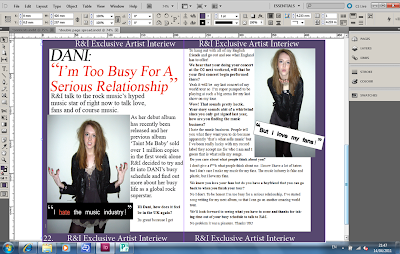
Comments from Audience 1
"I like the colours used throughout the magazine. I also feel as if I can look up to the artist featured. The colours andn artists the rock genre really well, but I dont really think I can see how Indie music is incorporated into it"
About Audience 1
Her name is Fiona, she is 17, loves going out to gigs,favourite music is indie/alternative music,lives in a small town.
Reflection on results from Audience 1
I asked Fiona to look at my magazine and fill out my feedback sheet because she's the type of audience that i'm aimed my magazine at. From these results I've found out although I incorperated the rock genre into my magazine, I havent done as much for Indie. I think that the style of my magazine (colour, masterhead) is in style as a rock magazine, however the artricles that it features focuses on both genres. Fiona also agreed that my front cover was the weakest element of my magazine, I'm disapointed in this because I feel as if I tried so hard to try and make it work, but I don't think it looks as professional as the other elements of my magazine. However she did say that she liekd tthe artist and felt that she could look up to her, I think that is a good result bercause many girls need role models to look up to.
Audience 2 Comments

"I love the conents and double page, because they look like you would actually see them in a proper magazine. The front cover is alright but I think its the colour or something that just isn't right with this front cover. I like the contents page becaue it actually made me wanna see some of the magazine articles, and I really like the interview because she seems like a well cool girl. But yeah overall I think its good."
About Audience 2
His name is David and he is 23, he lives in a small town, goes out clubbing and also is going to festivals this summer. Rock and dubstep are his favourite genre's music.
Reflection on Results from Audience 2
I decided to ask David for feedback because although hie like dubstep, he still liked rock msuic and is 23. This gives me the chance to find out about what people think who also have other music intrests and also in a higher age band. He also thinks that the front cover is not as strong as the other which I already know, but at least it shows that its not just me thinking that it doesn't look right. I think if I had more times I would definitly change my front cover. He talked about how he liked my contents page because it made him want to read the articles. This is good because thats what I wanted from the contents so that intrigues the audience to go and read the artcles. He also said how he like the artists, this is good because I wanted her to look edgy but also approachable and rewlatable to the audience.
Overall thoughts
Overall I think that although both audience aggreed that the front cover wasnt at the strongest, they both thought that the artist was relatable in some way. They also agreed that the text is as if they are talking to a friend and also think that the magazine represents the rock genre well, but maybe should incorperate the indie genre more. Overall I'm pleased with the feeback that I got because it helps me realise that what I've done wrong and understand how I could improve my magazine to be the best that I could make it.


 I have learnt so much through the duration of this project about technology. Before I started this project I would use Microsoft Publisher and Paint if I was ever going to do editing, however now I don’t think I could ever go back.
I have learnt so much through the duration of this project about technology. Before I started this project I would use Microsoft Publisher and Paint if I was ever going to do editing, however now I don’t think I could ever go back.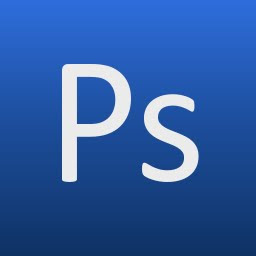



 BBC- Even though the BBC doesn’t have any magazines which are rock/indie magazine I think that my magazine wouldn’t be appropriate for the BBC brand.
BBC- Even though the BBC doesn’t have any magazines which are rock/indie magazine I think that my magazine wouldn’t be appropriate for the BBC brand. 










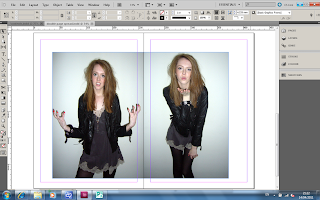 The next step I did was position the photo's where I wanted them and also set the background colour.
The next step I did was position the photo's where I wanted them and also set the background colour. 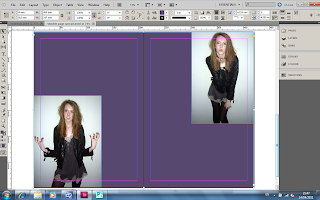 The next step I did was put the appropriate quotations next to the photo's on the document. To make the boxes around the quotations I clicked the 'Shape Tool' and drew a rectangle shape for the quote to go in.
The next step I did was put the appropriate quotations next to the photo's on the document. To make the boxes around the quotations I clicked the 'Shape Tool' and drew a rectangle shape for the quote to go in.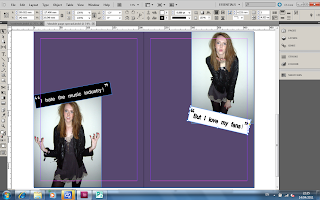 Before writing the actual interview I thought that the text wouldnt show up very good against the purple background. However I still didn't want a bland white double page spread. So i decided to draw a a white box with the purple background, so that way the text would still be clear but also I have the edgy purple colour.
Before writing the actual interview I thought that the text wouldnt show up very good against the purple background. However I still didn't want a bland white double page spread. So i decided to draw a a white box with the purple background, so that way the text would still be clear but also I have the edgy purple colour. 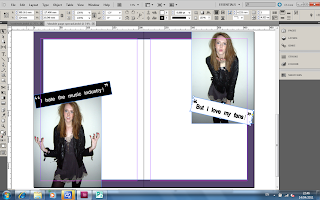 The next step I did was insert the headline to the spread. For the headline I used the font Times New Roman and the size was 60.
The next step I did was insert the headline to the spread. For the headline I used the font Times New Roman and the size was 60. This is what my spread looked like with the headline on the page.
This is what my spread looked like with the headline on the page.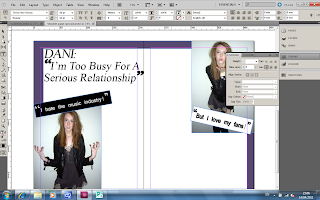 I then decided to change the colour of the text in the headline and also one of the quotes to give a wider variation of colour to the spread. To change the colour of the text I higlighted the text and pressed the stroke tool and changed the colour to red.
I then decided to change the colour of the text in the headline and also one of the quotes to give a wider variation of colour to the spread. To change the colour of the text I higlighted the text and pressed the stroke tool and changed the colour to red.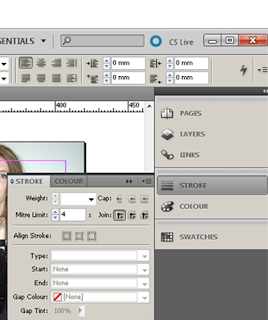 This is what it looked like with the change in colour.
This is what it looked like with the change in colour.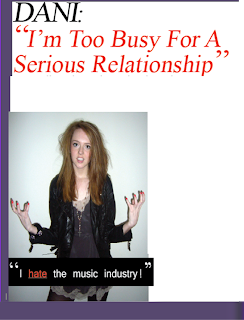
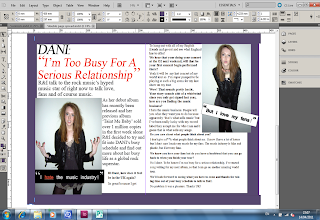 Around the purple boarder I decided to add some text to frame the spread. This is what it finally looks like.
Around the purple boarder I decided to add some text to frame the spread. This is what it finally looks like.